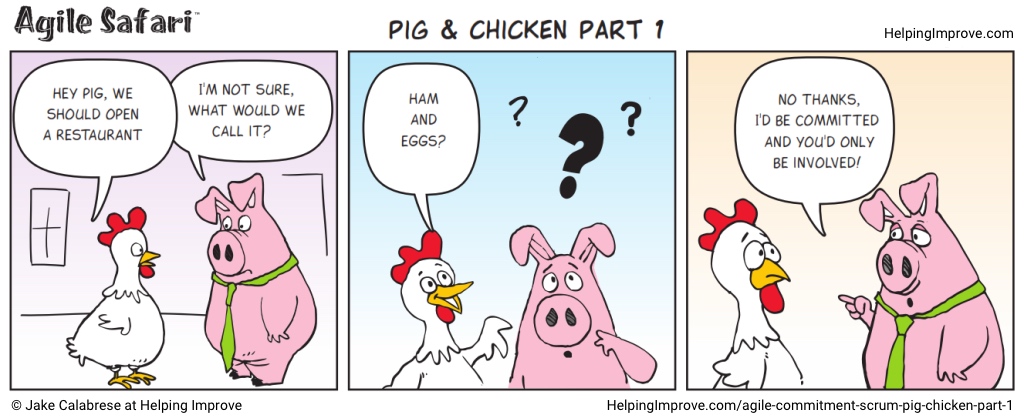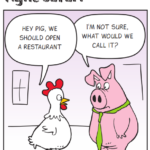The Pig & Chicken is a cartoon that many in the agile community are familiar with. I know some will see it and ask, why is this one being rehashed (I know this because I reviewed it with a few people and they asked). Some will be quite annoyed, since many “strongly dislike” the cartoon (which is fine – please add your comments!). So, for anyone reading this and thinking any of those things, please read on. I’d like to say “don’t worry, I have a plan”, but only you can judge for yourself how it pans out! Tweet the Agile Safari Cartoon!

What Is The Pig & Chicken Cartoon?
For readers who are not familiar with agile (or any agile folks who have not seen the cartoon), the ideas is that the pigs are the team (or Scrum Team). The chickens are everyone else.
So the premise is that the pig is fully committed to the restaurant — and in the case of a team, they are fully committed to the work. The chickens are involved, but never actually committed, since they are not part of the team. This can be an efficient way to explain the idea of a team committing to people and so it is often used in training, coaching, on websites, and likely in a few books (although I can’t recall any off the top of my head). The Pig & Chicken is described in the 2009 and 2010 versions of the Scrum Guide (it was removed in 2011 and is not included in the current version of the Scrum Guide).
Do We Still Have to Commit? After talking so much about commitment and that is a fair question. As I mentioned above, a while back, the Scrum Guide was changed to remove ‘commit’ from the language. The change replaced ‘commit’ with ‘forecast’. Some might be tired of the discussion and some may never have heard of it. In either case, if you are interested in it, check out Scrum Commitment or Forecast for more on the topic and my take.
Regarding the Pig & Chicken, there are different opinions on the cartoon, some pro and some con.
“The Pig & Chicken is Bad”
One point where things take a turn and people dislike the Pig & Chicken cartoon is when we lose context (my words). When using the cartoon in agile training for example, new teams may not know enough about agile (yet) to make the distinction. The context here is that the cartoon can work efficiently to explain how the team is committed and others are not — but when it is used with agile in general, it can be confusing because we begin to make assumptions on who the chickens are. If the chickens are defined as “anyone who is not on the team”, then maybe it works. If the chickens are defined as some other specific group, that can “introduce” mistrust. For example, when we hear “management is all chickens” or “the product team doesn’t actually do any work, they are chickens”, we know people are not understanding the intent of the cartoon. I’ve also heard many people on teams say they do not want to be referred to as pigs. I can understand that as well. Some point out that pigs are smarter than chickens. . . the list goes on. . . While I do not expect to cover all the issues, I will be tackling more of them in the upcoming cartoons.
“The Pig & Chicken is Fine”
There are also people on the other side of the ‘debate’ who say “who cares — it’s not a big deal.” I go back and forth on this. In large part I don’t see the cartoon as a major problem, just a tool to get people thinking. In Scrum Commitment or Forecast, I talk about the issue of assuming a word is going to make or break things for you. Looking at this in the same way, if the cartoon is causing major trust issues, you have a different problem.
That said, since I see this as a tool to get people thinking, is it?? Is the cartoon causing people to think? Is it causing people to discuss what it means to commit to get something done? The (classic) Pig & Chicken cartoon (I’m calling it Part 1) may not be as effective as it could be. Sure, people seem to get the point about teams quickly, but are there valuable discussions to be had? I believe there are!
I also believe there is a lot more to explore when we look at what it means to commit.
Why Are You Rehashing This Again?
I’m rehashing the Pig & Chicken for two reasons:
1. Shockingly to people who live in the Agile Village on Twitter (thanks Chris), not everyone has heard this one. So in this case, I’m not rehashing it.
2. I wanted to explore this idea more and needed a baseline to build on [Part 2 and Part 3 will be published in the next few weeks, and I’ll add the links here.]
Team Commitment
People should be working together. They should be committing as a team and working as a team to deliver. If they realize that it is not possible to deliver what they committed to, they should be committed, as a team, to having a conversation with the product people to come up with some options! AND. . . the product people should be committed to collaborating with the development team to find solutions and deliver value!
Should only the pigs be committed? Read Agile Pig & Chicken Part 2











I’m one of those people who dislike the pig and chicken metaphor, mostly because where people take it, as you mentioned in the section “The Pig & Chicken is Bad”.
The big problem I see is that some people who don’t want to realize that the metaphor is, well, a metaphor, take to labeling people as “pigs” or “chickens”. This is bad enough when taken out of context, but it is even detrimental when the people involved (or is that committed) do understand the context. Reinforcing the idea that “these people can talk” and “these people can’t” and applying the labels pig and chicken respectively just papers over the bigger issue that exists. There are these little rules about who can and cannot talk during standups or other Scrum cadence events because we’re avoiding the grown-up conversation that some people just need to step back and give the team ownership.
It may be fine to use process when teams start adopting agile to get things going, but the longer we stick with Pigs talk, chickens don’t I think we loose sight of *why* that particular rule really exists.
It’s more difficult, but I think more effective in the long run to address head on why those rules exist instead of creating a set of rules that can very easily turn teams into a cargo cult.
So I guess on the face of it, the metaphor isn’t bad… just the potential for people to unthinkingly apply it, and hang on to it, and lose sight of what it was really trying to tell us.
Kent, wow. well put. Thanks for the great comment.
Part 2 comes out in a few days and my hope is, it begins the process of unraveling the whole thing and opens up a conversation on the issues here. Perhaps even create a laugh or two. We will see.The idea that people just can’t talk is just so silly (or insert another word of your choice)! The rules do work to a point, but the point is fuzzy.
Part 2 should cover some of these items. It will be out in the next few days. Reading your comment, I think you beat me to the punch of a few things!